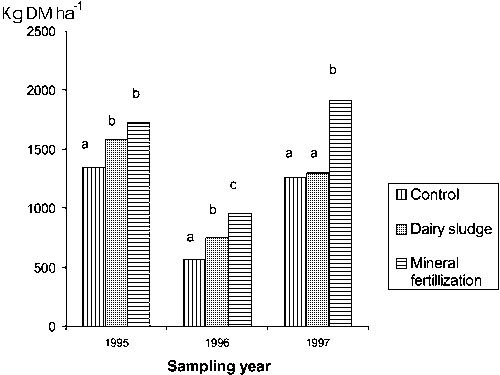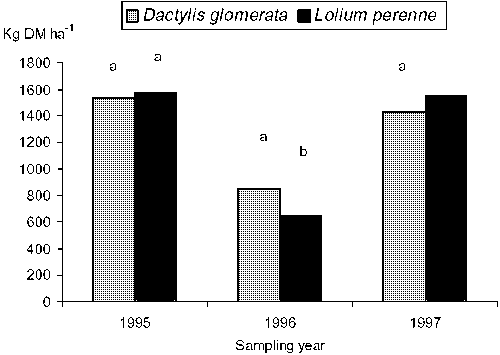Escuela Politécnica Superior, Universidad de Santiago de Compostela, 27002 Lugo, Spain
SUMMARY
In the spring of 1995 two types of permanent grassland (Dactylis glomerata-Trifolium sp. and Lolium perenne-Trifolium sp.) were sown in Castro de Ribeiras de Lea-Lugo (NW Spain) on silvicultural systems (two kinds of plantation frame). Grassland production was compared between control (without fertilization), mineral fertilizer (500 kg ha-1 of 8-24-16 complex application per year) and dairy-plant sludge fertilizer (154 m3 ha-1, DM= 25 g -1 l). The dairy sludge application was only in the first year, 1995. In July of each year (1995, 1996, 1997) four samples were randomly taken from each plot (72 sampling plots) and dry weight was determined.
In this study we found a positive residual effect of dairy sludge fertilization on grassland production in the second year after tree and meadow implementation. In the third year, dairy sludge effects as a fertilizer was not evident. The plantation frame showed a significant influence on forage production.
Keywords: dairy-sludge, fertilization, grassland, residual effect
INTRODUCTION
Nowadays, where a series of actions are prevailing focused to obtain a clean technology, there is an added problem, which is the elimination of the wastes that all industrial activity entails. Firstly, the resulting by-products have as a final destination their disposal in the garbage dump or their incineration. Nevertheless, specifically in the dairy-industries, the sludge produced from the sewage purification process has some properties such as its content in organic matter, N (nitrogen), P (phosphorous) and a low level in heavy metals (Moirón et al., 1997) which makes it suitable for its use as an agricultural fertilizer; this being a more acceptable disposal from the environmental point of view.
This work studied the application effects on the production of two grassland mixtures sown under a silvopastoral system. Applications were of an organic sludge composed mainly by a dairy industry sewage sludge in comparison with the mineral fertilization that is conventionally used in these cultivation systems, taking into account that the forest system (in this case, silvopastoral) are able to receive these wastes (Marx et al., 1995; Couillard, 1995).
MATERIAL AND METHODS
In May 1995, on a plot of 1 ha in the municipality of Castro Ribera de Lea (Lugo, Spain), an experiment was established on a silvopastoral system. This zone has a warm climate temperate (Papadakis regime) and soil type Gleyc Cambisol (FAO, 1991). The established design includes a total of 72 plots, 36 of which are 64 m2 and the others are 192 m2. The plot size is determined by the plantation frame of the species Betula alba and Pinus radiata. For each plot size, 18 were sown with the following grassland mixtures: Lolium perenne cv. Tove (25 kg ha-1), Trifolium repens cv. Ladino (4 kg ha-1) and Trifolium pratense cv. Marino (1 kg ha-1), in the others: Dactylis glomerata cv. Saborto (25 kg ha-1), Trifolium repens cv. Ladino (4 kg ha-1) and Trifolium pratense cv. Marino (1 kg ha-1).
In addition, in the sown plots with each grassland mixture, the following fertilizations were applied: T0: plots without fertilization, T1: plots with 500 kg ha-1of 8-24-16 per year and 3 t ha-1 of dolomite in the grassland establishment, along with 40 kg ha-1 of N as a calcium ammonium nitrate following first silage cut and T2: plots fertilized with liquid sludge of dairy sewage wastewater (154 m3 ha-1), applied only the year of trial establishment. The fertilizer composition of both treatments is summarized in Table 1.
Forage production was evaluated for two months after the grassland establishment (July 1995). The other two samplings were made during the following two years and on the same date, i.e. July 1996 and 1997. On each occasion and in all the plots, the sampling method was the launching at random of metal squares of 33 x 33 cm. In each one of these sub-samples (four in each plot) the forage was collected and dried in hot air stoves at 65ºC for 48 hours. Later it was weighed and the results were expressed in kg ha-1. The forage production in dry weight was analysed through an ANOVA to determine differences among treatments (previous normalization by Log and Squared root transformations).
Table 1. Fertilizer composition (kg ha-1) of both treatments. Dairy-sludge dry matter content was 25 g l-1.
|
Plots |
N |
P |
K |
Ca |
Mg |
|
T1 (mineral fertilization) |
40 |
52.3 |
66.4 |
421.8 |
138.0 |
|
T2 (dairy-sludge fertilization) |
40 |
37.4 |
21.0 |
189.9 |
19.6 |
RESULTS
In the year of the trial implantation, the grass production was similar for the plots fertilized with sludges and those fertilized with mineral fertilizer and significantly higher in both cases in reference to the control. A year later, the fertilization with sludges still had a positive effect on the grassland production, in reference to the control, but significantly lower to those fertilized with a mineral fertilizer yearly.
In the third year the sludge residual effect disappeared and the obtained products were not significantly superior to those in the plots without fertilizing, whereas there was still higher production in the plots fertilized with a mineral fertilizer regarding the control plots and those fertilized with sludges (Figure 1).
Regarding the plantation frame, there is a clear effect on production since in both first years the higher size plots produce more than the small plots, while in the third year this difference tends to disappear for p<0.05. On the other hand, this effect can be only and exclusively produced by the plot size, since there was no significant interaction between the variable plots and treatment (Figure 2).
Figure 1. Forage production (kg DM ha-1) by different types of fertilization (Control: absence of fertilization, Dairy sludge application and mineral fertilization), (a, b, c: significant differences at level p< 0.05)

Figure 2. Forage production (kg DM ha-1) by different plot size (small plot = 64 m2 and large plot = 192 m2), (a, b: significant differences at level p< 0.01).

Figure 3. Forage production (kg DM ha-1) by different meadow species (Dactylis glomerata and Lolium perenne), (a, b: significant differences at level p< 0.05).

Despite that previous work proved that prairie species more suitable for tree cover grassland in Galicia are Dactylis glomerata and Trifolium repens (Piñeiro, 1988), there were only significant differences between Dactylis-Lolium in the second year of sampling; related to differences produced by the plot size and treatment. This was born out by the degree of interaction of the variable species which was very high with the last two: p<0.01, whereas on the other two dates of sampling (July 1995 and July 1997), there was no significant interaction between species and the other two variables (plot size and fertilizing treatment) (Figure 3).
REFERENCES
Couillard, D. 1995. Dynamics of municipal wastewater sludges on forest land. Environmental Systems, Vol. 24 (1) 25-46.
FAO, 1991. The soil map of the world. FAO-UNESCO. Rome, 142 pp.
Marx, D.H., Berry, C.R. & Kormanik, P.P. 1995. Application of municipal sewage sludge to forest and degraded land. In: Agricultural utilization of urban and industrial by-products.
Karlen, D.L., Wright, R.J. & Kemper, W.O. (publishers), ASA Special Publication Number 58. Wisconsin, USA. pp: 275-295.
Moirón, C., Carral, E. & López-Mosquera, M.E. 1997. Contenu de metaux lourds dans des sols fertilises avec boues d'une industrie agroalimentaire. Experience pilote en Galice (NW Espagne). Deuxième Colloque International de Recherche sur les Sous-Produits de Traitement et d'Epuration des fluides. Rennes. France.
Piñeiro, J. & Pérez, M. 1988. Especies pratenses bajo pinar. Cuadernos de área de ciencias agrarias, nº 6. III Xornadas de Estudo sobor do tema. Produccions gandeiras de Galicia.